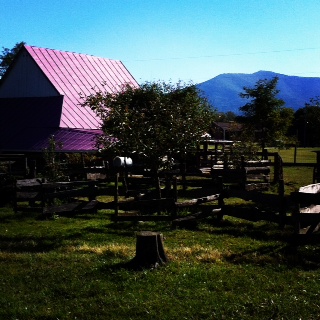 |
| Here's a view of Big Meadows Mountain in Shenandoah National Park, as seen from some of the new vines at Wisteria. |
 |
| Here's an orientation of the vineyard - the harvest progresses more or less from right to left. |
Although the hour was a little more civilized and there
weren’t any stalls to muck out, I’ll chalk up the experience as another
“internship” – similar to the one I had last year working with David at Public
House Produce, where I learned “up close and personal” about the craft of
raising excellent local food and agricultural products.
I posted about the experience in more detail a few weeks ago
(http://hawksbillcabin.blogspot.com/2012/09/scenes-from-vineyard.html
), but as volunteers we helped during the early stages of the winemaking
process. We picked, then worked the
destemming/crushing equipment, loaded the wine press and watched as the juice
or early wine poured out and was loaded in the casks to complete fermentation. Then we cleaned up – and there was a lot of
that, but it was fun too.
 |
| The barn, where the sheep and chickens reside, at Wisteria. Behind is the Blue Ridge and Shenandoah National Park. |
Just as I have learned with my new brewing hobby, cleaning
up is a big part of the process for these crafts. There are estimates that it takes 20 gallons
or so of water to make a gallon of wine, because of all the cleaning. In my home brewing experience, I’d say that I
probably use five gallons for every gallon I make, although I may be more
efficient when I start making five-gallon batches. But all of this effort is meant to ensure you
have a high-quality, safe, and tasty end product.
And that is definitely what you’ll find at Wisteria
Vineyard.
 |
| Red grapes, the last harvest at Wisteria. |
For Hawksbill Cabin readers, if you happen to be coming out
to visit the vineyard, give a yell – we’re only a half mile away, and maybe we
can meet you there.
No comments:
Post a Comment